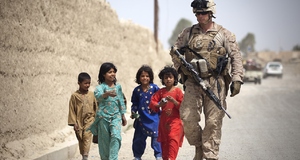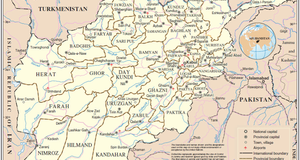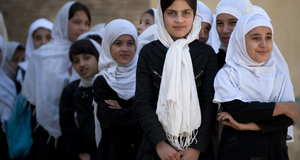From Cornell International Affairs Review VOL. 3 NO. 2Influence Operations as Counterinsurgency: A Strategy of Divisiveness
IN THIS ARTICLE
KEYWORDS
"Our forces were vastly superior to the rebels. Then why couldn't we finish with them quickly? Because they managed to mobilize the population through terror and persuasion. It was therefore imperative that we isolate the rebels from the population and that we gain the support of the population." – David Galula, Pacification in Algeria, 1956-1958 Since the invasion of Afghanistan in 2001 and Iraq in 2003, U.S. and coalition forces have found it difficult to win the "hearts and minds" of the civilian population. Like many other invading forces of the last half-century, the U.S. has found itself fighting an unmarked, non-state, and highly adaptable foe: the insurgent. Central to counterinsurgency doctrine (COIN) is the concept of winning the "hearts and minds" of the civilian population. Insurgencies derive their power from popular support. A powerful insurgency or counterinsurgency, therefore, has a firm grip on the hearts and minds of the people. In order to gain the support of the people, an invading force has to earn their trust and make them feel secure. Counterinsurgency theory treats civilians as pragmatists: they will lend their support to whichever party best represents their interests. Assuming civilian populations have an interest in self-preservation, the U.S., under the guidance of General Petraeus, has adopted a "population-centric" approach, making the security of the civilian population the first priority. It is essential that the U.S. provide better protection for the people than the insurgents ever could. That being said, providing security, while necessary, is not sufficient for earning the support of the people. Winning the hearts and minds of the people is far easier said than done. According to David Galula, a notable French counterinsurgency theorist, one of the most essential conditions of victory in counterinsurgency is "the permanent isolation of the insurgent from the population not enforced upon the population but maintained by and with the population."1 Separating the insurgency from the population both physically and politically is an often overlooked but nonetheless essential step in the hearts and minds process. The population will not reject the influence of the insurgency without having first become disaffected from the insurgency. Moreover, it is impossible for a counterinsurgent force to build relationships with a population that remains unwaveringly aligned with and connected to the insurgency. Successful insurgencies will have established deep roots within the community, and, as a result, this permanent isolation will be more difficult to achieve. The success or failure of a counterinsurgency campaign depends as much on how the people perceive their presence as it does on their actual military strength. If the insurgency has had an antiAmerican propaganda campaign in place for several years, entrenched beliefs regarding the invading American force will make gaining civilians' trust extremely difficult, especially with force as their only tool. Australian counterinsurgency guru David Kilcullen observes that while "we typically design physical operations first, then craft supporting information operations to explain our actions," Al Qaeda does "the reverse."2 Al Qaeda's physical operations are only possible because of the support they have already cultivated through influence operations. This is one of the most frequently ignored asymmetries of counterinsurgency warfare. While the U.S. may have far superior military technology and might, when it comes to influence operations, the U.S. has been inferior. This is the nature of counterinsurgency warfare. Galula bluntly declared, "If there was a field in which we were definitely and infinitely more stupid than our opponents, it was propaganda."3 The U.S. must adopt wellresearched and targeted influence operations to correct this asymmetry and effectively combat the influence of groups like Al Qaeda. Galula cites an axiom stating that in insurgency warfare "the population is split among three groups: (1) an active minority for the cause, (2) a neutral majority, (3) an active minority against the cause."4 If the U.S. can successfully use influence operations to mobilize the neutral majority or to neutralize the active minority that supports the insurgency, thus isolating them from the insurgency, they can significantly weaken Al Qaeda and similar organizations that rely so heavily on their own influence operations. "Separating the insurgency from the population both physically and politically is an often overlooked but nonetheless essential step in the hearts and minds process." Identifying these groups and designing influence operations targeting them is essential to efficiently isolating an insurgency from its support base. Just as targeted sanctions are used to coerce influential individuals and groups in societies, influence operations must target the groups from whom the insurgency draws their most vital support. According to Mao, the insurgent swims in the population as a fish swims in water.5 The environment in which an insurgency thrives is one where it enjoys strong popular support. Popular support is the chief asset of an insurgent group. Effective counterinsurgency must target that asset through operations designed to isolate the insurgency from the population both physically and politically. To use influence operations to achieve that isolation an operation must first investigate and identify where the insurgency and its support base are most likely to hold disparate interests and then attempt to highlight that disparity through influence operations. The Model: Highlighting the Difference in PeruA perfect example of this approach is the joint U.S.-Peruvian effort to subvert the influence of the Shining Path insurgent group in the 1980s. William Yaworsky describes this strategy in his account of U.S. Army psychological operations in Peru. Yaworsky recounts the structure and planning of Project Inti, the psychological campaign targeting the support of the Sendero Luminoso Maoist insurgency in Peru. Near the beginning of the paper, Yaworsky notes that Sendero, under former professor Abimael Guzman, spent ten years "ingratiating themselves into the local society" prior to launching their first physical operations in 1980, thus supporting Kilcullen's hypothesis regarding the order in which insurgent groups launch physical and influence operations6. The joint U.S.-Peruvian task force decided to primarily target "pre-militant members/recruits" of Sendero Luminoso.7 These recruits resemble Kilcullen's "Accidental Guerrilla."8 They are former members of the neutral majority that have been seduced and co-opted by the insurgency. In order to prevent this co-option, the counterinsurgent must become present, either physically or through information, thus countering the influence of the insurgency. The insurgency may be responsible for the population's security or its economy. Strategic influence operations can be applied in either case to facilitate the counterinsurgency's efforts to separate the insurgency from the population and take over their role in society. In this case, the U.S.-Peruvian coalition chose to counter the influence of the insurgency by disturbing the co-option process of these "pre-militant members" of the insurgency. To disturb this process, they used information to highlight divergent interests between the targeted group and the insurgency. Yaworsky explains how, through anthropological research, the task force recognized "the family orientation of recruits" as a divergence from the brutal nature of Sendero. Because Peruvian society valued "extremely close-knit interpersonal relationships within" the family unit, "pre-militant inductees had to calculate the repercussions their actions had on their families."9 They had to consider both the brutality of Sendero and the brutality of the Armed Forces' reaction. As time progressed, however, "the Armed Forces became more humane," and Sendero became "harsher and more indiscriminate," thus simplifying the target audience's decision, in favor of the government.10 This dilemma was developed and facilitated by influence operations highlighting the issue of family-orientation. The Sunni Awakening in Iraq: Influence UntappedIn late 2007, momentum in Iraq began to shift in the Coalition's favor. The shift is mainly attributed to the Coalition's ‘surge,' but another significant factor was the rebellion of Sunni tribes against al Qaeda, their former allies. Although improved security did not "spread exclusively because of tribes' rejection of al Qaeda," as Kimberly Kagan correctly asserts, the Sunni Awakening, as it has been termed, is an important example because it demonstrates how an insurgency's vulnerability can explode and, as a result, isolate them from the population.11 David Kilcullen attributes the Sunni Awakening to al Qaeda's "exclusive emphasis on religion and disregard of custom."12 One of Kilcullen's "informants" provides the useful anecdote of al Qaeda asking the tribes for "their women in marriage" and the tribes taking offense and declining on the basis of al Qaeda being outsiders to whom it is against tribal custom to give their women. Al Qaeda responded by dismissing tribal custom as "ignorant" according to the Qu'ran.13 This triggered a conflict between the tribes and al Qaeda resulting in the disaffection of the "accidental guerrillas," being the Sunni tribes, from al Qaeda.14 The difficulty in distinguishing between insurgents and civilians makes it difficult for armed forces to rebuild a community both physically and mentally. The months and years preceding the surge and the Sunni Awakening were the bloodiest and least productive period of the war. This begs the question: Could anything have been done to bring about the positive change that resulted from the surge and the rebellion a bit earlier? As demonstrated in the Sunni Awakening, the disaffection of Sunni tribes from al Qaeda contributed to gains in security for Iraqis beginning in late 2007. Targeted influence operations highlighting potential points of dissonance between the tribes and insurgency, much like those Yaworsky and his colleagues implemented in Peru, could have triggered the conflict, and the subsequent weakening of the insurgency, earlier. Dynamics between tribes and insurgent groups are often helpful for identifying divergent interests. Bear in mind, however, that this dynamic, a product of the values put on religion, glory, nationalism, tribal customs, etc., is extremely unlikely to be identical in any two cases. This strategy cannot be applied blindly. Any suggestion for tribal engagement in Afghanistan, for example, on the basis of the Sunni Awakening in Iraq alone is, therefore, inherently flawed and ignorant. Afghanistan: Disparate Priorities and Alternative OptionsIt's more difficult to find where insurgent and Afghan, specifically Pashtun, interests diverge because the extremists have been there for such a long time now. They cannot easily be exposed as an invading foreign presence because they've been there long enough to weave themselves into the political and cultural fabric of Pashtun regions. While during the Soviet-Afghan War some Afghan mujahideen resented foreign extremist volunteers like the young Osama Bin Laden, that division does not exist in the same capacity today. Not to mention that as the Taliban is the former government, certain groups are bound to support them out of habit rather than the opportunism Kilcullen's "Accidental Guerrilla Syndrome" would suggest. Moreover, their constituency is very familiar with their platforms and principles. There is no secret motive to be illuminated nor is there any obvious deviation from Pashtun culture, as there was in the Yaworsky example. The Taliban has been studying their constituency for nearly twenty years; they know better than to diverge from them culturally or religiously. For this reason, Kilcullen points to their economic platform, the poppy, as their vulnerability. His first suggestion is to further restrict poppy trade to prove that the Taliban cannot, in fact, protect their constituents' poppy. His second is to highlight inconsistencies in Taliban and Islamic policies towards drugs.15 The first suggestion bears the same risks as all economic warfare and sanctions: the targeted government, in this case the insurgent Taliban, will blame the costs born by the people on the foreign and domestic forces imposing the restrictions. Rather than losing popular support they will rally against the counterinsurgency. The second suggestion requires the Afghan government to take the religious high ground, which it will have a hard time holding as long as the opposition is Islamic fundamentalist.Continued on Next Page » Suggested Reading from Inquiries Journal
Inquiries Journal provides undergraduate and graduate students around the world a platform for the wide dissemination of academic work over a range of core disciplines. Representing the work of students from hundreds of institutions around the globe, Inquiries Journal's large database of academic articles is completely free. Learn more | Blog | Submit Latest in International Affairs |


















